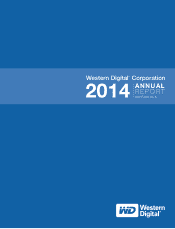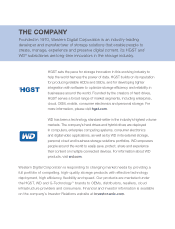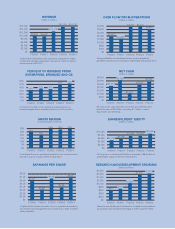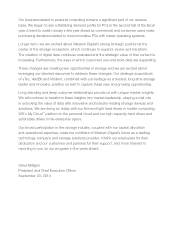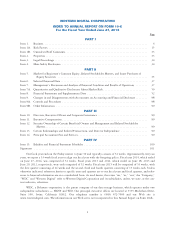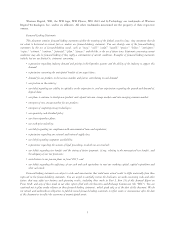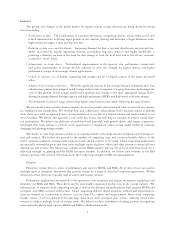Western Digital 2014 Annual Report Download - page 11
Download and view the complete annual report
Please find page 11 of the 2014 Western Digital annual report below. You can navigate through the pages in the report by either clicking on the pages listed below, or by using the keyword search tool below to find specific information within the annual report.Industry
The growth and changes in the global market for digital content storage solutions are being driven by several
factors including:
‰Proliferation of data. The proliferation of consumer electronics, computing devices, social media and cloud-
related infrastructure is driving rapid growth in the creation, sharing and retention of high definition video,
high resolution images, e-mail and big data files.
‰Evolution in data access and distribution. Increasing demand for data access and distribution anytime and any-
where, facilitated by rapidly improving network accessibility, big data analytics and higher bandwidth, is
powering a dramatic increase in the need for data storage at both the local level and at the off-site, network-
accessed or “cloud” levels.
‰Advancements in storage devices. Technological improvements in the capacity, size, performance, connectivity
and power requirements of storage devices continue to meet the demand for higher density and higher
performance storage in increasingly diverse applications.
‰Growth in consumers’ use of mobile computing and storage and use of digital content in the home and small
office.
‰Adoption of tiered storage architectures. With the significant increase in data storage demand, enterprises and cloud
infrastructure players have adopted tiered storage architectures to improve storage performance and manage the
costs of this growth. Tiered storage architectures optimize data storage to the most appropriate storage device,
driving increasing demand for high capacity and high performance HDDs and flash-based solid-state storage.
‰The development of advanced storage solutions that bypass tiered architectures while delivering the same benefits.
We are a market and customer driven company, focused on growth, innovation and value creation for our custom-
ers, employees and shareholders. We develop deep and collaborative relationships with customers aimed at making
them more successful, an approach that is being manifested in our role as a trusted advisor and market maker in our
served markets. We believe this approach is one of the key factors that will help us continue to achieve strong finan-
cial performance. We believe our platform is broad-based and powerful, with growth drivers and unique competitive
advantages that will continue to provide us the opportunity to expand our value-creation model within an evolving,
changing and growing storage market.
The ability to store large amounts of data is an ongoing enabler of the large amount of digital content being cre-
ated and utilized. We believe the growth in the number of computing users and connected mobile devices in the
world continues unabated, creating more usage and more digital content to be stored. Cloud computing applications
are especially noteworthy given that they create multiple copies of photos, videos and other content to ensure efficient
distribution and security. We believe unit volumes in the HDD industry were up 3% in fiscal 2014 from fiscal 2013,
reflecting strength in gaming and the HDD enterprise markets. In addition, we believe unit volumes in the SSD
industry were up 24% in fiscal 2014 from fiscal 2013, reflecting strength in SSD enterprise markets.
Enterprise
Enterprise storage devices consist of performance and capacity HDDs, and SSDs. All of these devices are used in
multiple types of enterprise datacenters that provide storage for a range of cloud and corporate applications. Within
datacenters, these drives are typically used in servers and storage systems.
Performance applications are essential to the operations of an enterprise and require the greatest capabilities and
reliability in HDDs and SSDs. These drives are the most highly engineered product line in the storage industry. The
infrastructure to support cloud computing storage is driving the demand for multi-platter high capacity HDDs and
enterprise class SSDs in tiered architectures. Cloud computing delivers shared resources, software and information to
users on demand on a multitude of devices, such as client PCs, tablets and smart phones. Most cloud computing
models consist of services delivered through large datacenters with enterprise-class servers, utilizing tiered archi-
tectures to address multiple levels of storage needs. We believe we have established a leading position in supplying
advanced multi-platter high capacity HDDs and SSDs to address these needs.
5

